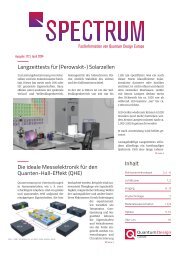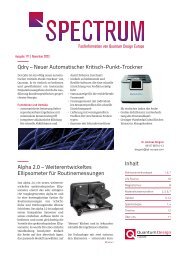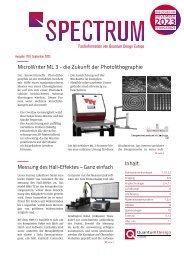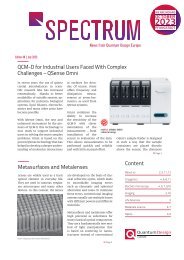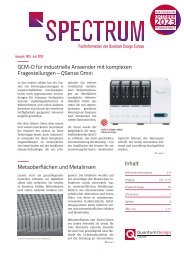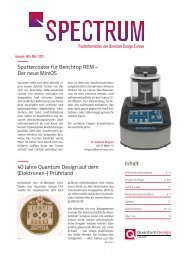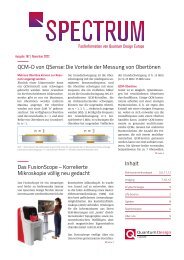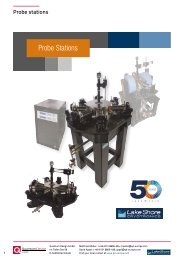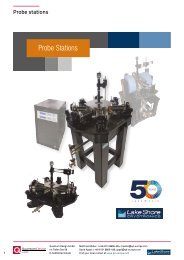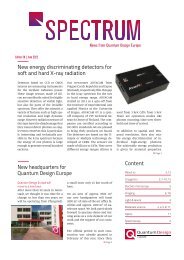Spectrum E39
Create successful ePaper yourself
Turn your PDF publications into a flip-book with our unique Google optimized e-Paper software.
Imaging<br />
Chemical analysis of materials with high atomic numbers (Z)<br />
with our laboratory XAS system<br />
X-ray absorption spectroscopy (XAS)<br />
is a powerful method for studying<br />
chemical states and the coordinated<br />
environments of selected elements.<br />
XAS has been commercially<br />
available for laboratory use for several<br />
years. In this report, we demonstrate<br />
the exceptional performance<br />
of Sigray's QuantumLeap H2000 for<br />
high-energy XAS on a Zr sample at<br />
17998 eV.<br />
Many laboratory XAS systems have<br />
difficulty at energies >12 keV due<br />
The QuantumLeap H-series is optimized<br />
for a wide energy range from<br />
4.5 and 25 keV. In particular, the capacities<br />
in the high-energy range<br />
between 12 and 25 keV are of great<br />
importance for numerous nuclear<br />
applications as well as in catalysis.<br />
Absorption<br />
Zr foil<br />
QuantumLeap<br />
Synchrotron<br />
18000 18200 18400 18600<br />
Energy (eV)<br />
Fig. 2: Zr K-edge (17998 eV) XANES and EXAFS of a Zr<br />
film obtained with QuantumLeap (black), with comparative<br />
synchrotron data (red)<br />
Lanthanoide<br />
Actinoide<br />
Periodic Table of the Elements<br />
Fig. 1: Periodic table of the elements with highlighting of the elements with L- and K-edges between 12 and 25<br />
keV. K-edges are shown in green, L-edges in turquoise<br />
to increasing sagittal errors for Johann<br />
geometries at high energies.<br />
This is problematic because many<br />
important catalysts (Pt and Zr) and<br />
actinoids (U, Pu, Th, etc.) have L and<br />
K edges in the 12 to 25 keV range (see<br />
Fig. 1).<br />
Experiments and results<br />
We have used the QuantumLeap on<br />
a Zr foil with a thickness of 7.5 µm<br />
to demonstrate the capabilities offered<br />
by the system in high energy<br />
X-ray near edge absorption spectroscopy<br />
(XANES) and X-ray absorption<br />
fine structure (EXAFS) analysis<br />
Method<br />
Using intuitive software, the K-edge<br />
of Zr was selected from the periodic<br />
table of the elements.<br />
Fig. 2). The XAS data were processed<br />
and analyzed using the Athena and<br />
Artemis programs of the IFEFFIT package<br />
[1].<br />
Results and discussion<br />
Quantitative analysis of the Zr<br />
K-edge EXAFS was performed by<br />
fitting theoretical EXAFS spectra<br />
to the experimental data in<br />
R-space to obtain structural parameters<br />
(see Table 1). Included were<br />
the coordination number N, the<br />
bond length R, and the perturbation<br />
factor σ2. The scattering contributions<br />
from the shortest Zr-Zr<br />
bond of 3.21 Å are also included.<br />
The correlation between bond<br />
length and perturbation factors between<br />
synchrotron and QuantumLeap<br />
data is excellent. The error bars<br />
of all parameters are small, which<br />
emphasizes the reliability of the results.<br />
Summary<br />
We have demonstrated that la-<br />
Sigray's QuantumLeap X-ray absorption<br />
spectroscopy systems are the<br />
first XAS laboratory instruments<br />
with synchrotron-like capabilities.<br />
The QuantumLeap systems combine<br />
several patented features, e.g.<br />
■ ultra-bright X-ray sources, the<br />
imaging technology and<br />
■ the system design<br />
The system automatically<br />
selected the<br />
appropriate crystal<br />
– a cylindrically bent<br />
Johansson crystal Ge<br />
(800). An energy spectrum<br />
of 17.8-18.7 keV<br />
(wavenumber k=~13<br />
Å-1) was produced within<br />
seven hours (see<br />
8<br />
Strukturparameter Synchrotron Sigray QuantumLeap<br />
N 12 12<br />
R (Å) 3,23 ± 0,01 3,21 ± 0,01<br />
σ2 (Å2) 0,009 ± 0,001 0,012 ± 0,002<br />
Synchrotron and Sigray QuantumLeap Zr spectra (17.8 to 18.7 keV) were<br />
analyzed with Artemis. The results show excellent agreement with each<br />
other, demonstrating the exceptional high-energy XAS capabilities of the<br />
QuantumLeap<br />
Seite 9




